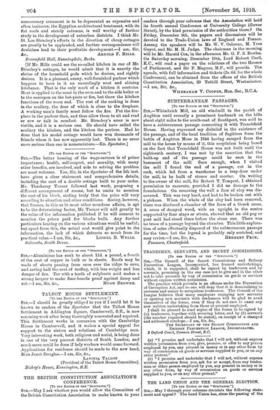SUBTERRANEAN PASSAGES.
[To THE EDITOR OF THE "SPECTATOR:9
Sm,—Whimbrick Mill, an old windmill in the parish of Aughton until recently a prominent landmark on the hills about eight miles to the south-east of Southport, was said to have a subterranean passage connecting it with Trenchfield House. Having expressed my disbelief in the existence of the passage, and of the local tradition of fugitives from the battle of Aughton Moss in 1644 having escaped from the mill to the house by means of it, this scepticism being based on the fact that Trenchfield House was not built until the eighteenth century, I was met by the assertion that the built-up end of the passage could be seen in the basement of the mill: Sure enough, when I visited the mill I found the end of a passage, cut in the rook, which led from a warehouse to a trap-door under the mill; to be built of stones and mortar. On writing to the owner of the mill, Sir Robert T. Tempest, I obtained permission to excavate, provided I did no damage to the foundations. On removing the wall a face of clay was dis- covered. This was very hard, and had to be broken out with a pickaxe. When the whole of the clay had been removed, there was disclosed a chamber of the form of a Greek cross. A cross of decayed wood, with an upright in the centre supported by four stays or struts, showed that an old peg or post mill had stood there before the stone one. There was no trace of a passage beyond the chamber. This little explora- tion of mine effectually disposed of the subterranean passage for the time, but the legend is probably only scotched, and


















































 Previous page
Previous page